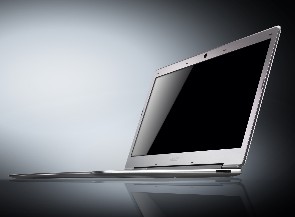|
HOME
Technology Dec 2011 Ultrabook reshapes market Portable computing reinvented |
|
“Advances in technology and changing media habits mean less moving parts — the spinning platter hard drive and the CD/DVD are out and solid state internal and removable disks are in.” The portable computing market, pushed along by the growing influence of the tablet in all its shapes and forms has spawned a range of lighter, sleeker hybrid devices and PC replacements. As the digital revolution matures there’s a growing desire to get rid of anything that moves, compress the space where mechanical devices once held sway, and deliver smaller, smarter, faster computing devices. Intel, which makes 80 percent of the world's microprocessors and its main competitor Advanced Micro Devices (AMD), are continually adapting to produce smaller better performing chipsets that drain less battery power in mobile devices, including smart phones.
While the tablet is still clearly marking out a growing niche in the
world of multimedia mobility, where social networking is king and high
definition viewing is paramount, a new notebook category is claiming its
own territory.
Ultrabook
evangelists Product with processing power from rival chipmaker AMD is expecting to begin rolling out in early in 2012.
The reason the ultra 13-20mm thick format and 13–15.6 inch screen can
slim down so graciously has a lot to do with what’s been left out. Dick Smith marketing services manager Francois Smith, suggests fewer people are using CDs and no longer need an optical CD drive. The SD card and the USB slot are sufficient to transfer content and plug in external devices. The ultrabook format starts almost instantly and because there’s no spin up time for the hard disk there’s less drain on power — battery life is typically 6-7 hours.
These notebooks are typically designer sculpted items with brushed
stainless steel finishes or streamlined curves.
Most use
Intel’s second generation Core processor, will wake up in seconds and
use smartphone style touch pads. Apple which already claims to be competing with its Macbook Air 13inch is rumoured to be working an ultrathin 15 inch Macbook Air.
Tablet gaining ground During 2011 tablets sold about 50 million units worldwide with analysts expecting that to double in 2012, although that doesn’t yet rate alongside IDC’s estimate of 362 million PC sales in 2011. Tablet take up remains a source of concern for traditional computer makers; about a third of the tablets sold over the next two years are likely to be at the expense of laptops. It’s a buyer’s market with branded solidly configured laptops selling for $600 - $1000 and netbooks, the last attempt to at improving on the lightweight notebook, now selling for $300 - $500. With uber-thin ultrabooks and even hybrid e-books now competing its game on. Many PC makers including Hewlett-Packard, Dell and Lenovo have added tablet style products to their armoury to stem the flood to Apple, which first began selling its iPad in April 2010. Local IDC tablet numbers suggest 156,000 tablet sales by year’s end with shipments of Apple’s iPad 2 doubling, giving it an estimated 70 percent market share. However tablets featuring Google’s Android operating system are growing quicker, peeling around 10 percent off Apple’s first quarter sales. The bulk of Android tablets were sold through the major carriers; the Samsung Galaxy Tab through Vodafone and other retailers and Motorola’s Xoom through Telecom. For an example of features and the direction things are moving in take a look at the 9.4 inch Sony Tablet S running the Android Honeycomb operating system. It has HD video recorder, twin cameras, microphone, GPS and wifi and optional 3G capability.
The touch
screen unit is PlayStation certified, geared as a music player, a
universal controller for your TV, PVR, DVD player, sound system, a web
browser and e-book reader all in a dual screen folding design.
Steep
curve ahead Android tablets were expected to account for around 17 percent of sales with other platforms confined to about 5 percent. In 2012 however Gartner expects Android will begin gaining ground with a 22 percent market share worldwide with Apple holding 50 percent share until 2014. It’s believed the
key to Apple’s success is the unified user experience across hardware
and software platforms and services. Unless competitors can offer
something similar Gartner believes their impact will remain minimal. The netbook will retain its own niche for those wanting a small form factor, lower powered internet and wifi terminals with limited computing capabilities for portability and travel. “You might have an ultra thin for business to handle word processing and spreadsheets because of the keyboard and screen size and use a tablet for watching movies, social networking, reading a book or to share with the kids,” suggests Smith. Meanwhile there’s no letting up in the innovation department for notebooks of all shapes and sizes. Screen technology, backlighting, enhanced audio and media handling, designer makeovers and colour schemes, portability and affordable are evident in new releases from all the major players. |
